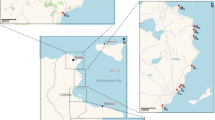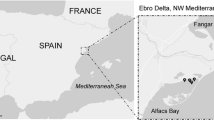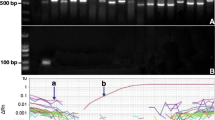Abstract
Karlodinium veneficum is a toxic benthic globally distributed dinoflagellate which has direct impacts on human health and the environment. Early and accurate detection of this harmful algal bloom-forming species could be useful for potential risks monitoring and management. In the present work, a real-time PCR targeting the internal transcribed spacer ribosomal DNA region for the specific detection and absolute quantification of K. veneficum was designed. Then, the assay conditions were adjusted and validated. The developed qPCR was highly specific for the target species and displayed no cross-reactivity with closely related dinoflagellates and/or other microalgal species commonly distributed along the Tunisian coast. Its lowest detection limit was 5 rDNA copies per reaction, which is often considered satisfying. qPCR assay enumeration accuracy was evaluated using artificially inoculated environmental samples. The comparison of the cell abundance estimates obtained by qPCR assay with the theoretical estimates showed no statistically significant difference across a range of concentrations. We suggest that the qPCR approach developed in the present study may be a valuable tool to investigate the distribution and seasonal dynamics of K. veneficum in marine environments.



Similar content being viewed by others
Data availability
All data generated or analysed during this study are included in this published article.
References
Abdelkafi S, Chamkha M, Casalot L et al (2005) Isolation and characterization of a novel Bacillus sp., strain YAS1, capable of transforming tyrosol under hypersaline conditions. FEMS Microbiol Lett 252:79–84. https://doi.org/10.1016/j.femsle.2005.08.032
Abdelkafi S, Labat M, Casalot L et al (2006) Isolation and characterization of Halomonas sp. strain IMPC, a p-coumaric acid-metabolizing bacterium that decarboxylates other cinnamic acids under hypersaline conditions. FEMS Microbiol Lett 255:108–114. https://doi.org/10.1111/j.1574-6968.2005.00061.x
Abdelkafi S, Labat M, Ben Ali Gam Z et al (2008) Optimized conditions for the synthesis of vanillic acid under hypersaline conditions by Halomonas elongata DSM 2581T resting cells. World J Microbiol Biotechnol 24:675–680. https://doi.org/10.1007/s11274-007-9523-3
Adolf JE, Bachvaroff T, Place AR (2008) Can cryptophyte abundance trigger toxic Karlodinium veneficum blooms in eutrophic estuaries? Harmful Algae 8(1):119–128. https://doi.org/10.1016/j.hal.2008.08.003
Antonella P, Luca G (2013) The quantitative real-time PCR applications in the monitoring of marine harmful algal bloom (HAB) species. Environ Sci Pollut Res Int 20(10):6851–6862. https://doi.org/10.1007/s11356-012-1377-z
Baccari O, Elleuch J, Barkallah M et al (2020) Development of a new TaqMan-based PCR assay for the specific detection and quantification of Simkania negevensis. Mol Cell Probes 53:101645. https://doi.org/10.1016/j.mcp.2020.101645
Barkallah M, Elleuch J, Smith KF et al (2020) Development and application of a real-time PCR assay for the sensitive detection of diarrheic toxin producer Prorocentrum lima. J Microbiol Methods 178:106081. https://doi.org/10.1016/j.mimet.2020.106081
Ben Amor F, Elleuch J, Farhat A et al (2022) Development of a novel TaqMan qPCR assay for rapid detection and quantification of Gymnodinium catenatum for application to harmful algal bloom monitoring in coastal areas of Tunisia. Environ Sci Pollut Res Int. https://doi.org/10.1007/s11356-022-20273-3
Brink AM, Kremp A, Gorokhova E (2019) Quantitative real-time PCR assays for species-specific detection and quantification of Baltic Sea spring bloom dinoflagellates. BioRxiv 871020. https://doi.org/10.1101/871020
Cai P, He S, Zhou C et al (2016) Two new karlotoxins found in Karlodinium veneficum (strain GM2) from the East China Sea. Harmful Algae 58:66–73. https://doi.org/10.1016/j.hal.2016.08.001
Chen GF, Wang GC, Zhang CY, Zhou BC (2009) Advances in the molecular detection techniques for red tide algae. High Technol Lett 19:17–25
Chen GF, Liu Y, Zhang CY et al (2013) Development of rRNA-targeted probes for detection of Prorocentrum micans (Dinophyceae) using whole cell in situ hybridization. J Appl Psychol 25(4):1077–1089. https://doi.org/10.1007/s10811-012-9920-3
Cho ES, Kim GY, Choi BD et al (2001) A comparative study of the harmful dinoflagellates Cochlodinium polykrikoides and Gyrodinium impudicum using transmission electron microscopy, fatty acid composition, carotenoid content, DNA quantification and gene sequences. Bot Mar 44(1):57–66. https://doi.org/10.1515/BOT.2001.008
Ciglenečki UJ, Toplak I (2012) Development of a real-time RT-PCR assay with TaqMan probe for specific detection of acute bee paralysis virus. J Virol Methods 184(1–2):63–68. https://doi.org/10.1016/j.jviromet.2012.05.010
Dammak-Zouari H, Hamza A, Bouain A (2009) Gymnodiniales in the Gulf of Gabes (Tunisia). Cahiers de biologie marine 50(2):153–170
Deeds JR, Hoesch RE, Place AR, Kao JP (2015) The cytotoxic mechanism of karlotoxin 2 (KmTx 2) from Karlodinium veneficum (Dinophyceae). Aquat Toxicol 159:148–155. https://doi.org/10.1016/j.hal.2020.101804
Deeds JR, Terlizzi DE, Adolf JE et al (2002) Toxic activity from cultures of Karlodinium micrum (= Gyrodinium galatheanum)(Dinophyceae) -a dinoflagellate associated with fish mortalities in an estuarine aquaculture facility. Harmful Algae 1(2):169–189. https://doi.org/10.1016/S1568-9883(02)00027-6
Drira M, Elleuch J, Ben Hlima H et al (2021) Optimization of exopolysaccharides production by Porphyridium sordidum and their potential to induce defense responses in Arabidopsis thaliana against Fusarium oxysporum. Biomolecules 11(2):282. https://doi.org/10.3390/biom11020282
Elleuch J, Zghal RZ, Jemaà M et al (2014) New Bacillus thuringiensis toxin combinations for biological control of lepidopteran larvae. Int J Biol Macromol 65:148–154. https://doi.org/10.1016/j.ijbiomac.2014.01.029
Elleuch J, Tounsi S, Belguith Ben Hassen N et al (2015a) Characterisation of novel Bacillus thuringiensis isolates against Aedes aegypti (Diptera: Culicidae) and Ceratitis capitata (Diptera: Tephridae). J Invertebr Pathol 124:90–97. https://doi.org/10.1016/j.jip.2014.11.005
Elleuch J, Zghal RZ, Lacoix MN et al (2015b) Evidence of two mechanisms involved in Bacillus thuringiensis israelensis decreased toxicity against mosquito larvae: genome dynamic and toxins stability. Microbiol Res 176:48–54. https://doi.org/10.1016/j.micres.2015.04.007
Elleuch J, Barkallah M, Smith KF et al (2020) Quantitative PCR assay for the simultaneous identification and enumeration of multiple Karenia species. Environ Sci Pollut Res Int 27(29):36889–36899. https://doi.org/10.1007/s11356-020-09739-4
Elleuch J, Ben Amor F, Barkallah M et al (2021a) q-PCR-based assay for the toxic dinoflagellate Karenia selliformis monitoring along the Tunisian coasts. Environ Sci Pollut Res Int 28(41):57486–57498. https://doi.org/10.1007/s11356-021-14597-9
Elleuch J, Ben Amor F, Chaaben Z et al (2021b) Zinc biosorption by Dunaliella sp. AL-1: mechanism and effects on cell metabolism. Sci Total Environ 773:145024. https://doi.org/10.1016/j.scitotenv.2021.145024
Elleuch J, Hmani R, Drira M et al (2021c) Potential of three local marine microalgae from Tunisian coasts for cadmium, lead and chromium removals. Sci Total Environ 799:149464. https://doi.org/10.1016/j.scitotenv.2021.149464
Feki-Sahnoun W, Njah H, Hamza A et al (2020) Using a naive Bayes classifier to explore the factors driving the harmful dinoflagellate Karenia selliformis blooms in a southeastern Mediterranean lagoon. Ocean Dyn 70(7):897–911. https://doi.org/10.1007/s10236-020-01365-5
Fensin EE (2006) Impact of tropical storms and drought on the dinoflagellates Karlodinium micrum and Prorocentrum minimum in estuarine rivers of North Carolina, USA. Afr J Mar Sci 28:277–281
Fu M, Chen G, Zhang C et al (2019) Rapid and sensitive detection method for Karlodinium veneficum by recombinase polymerase amplification coupled with lateral flow dipstick. Harmful Algae 84:1–9. https://doi.org/10.1016/j.hal.2019.01.011
Godhe A, Asplund ME, Härnström K et al (2008) Quantification of diatom and dinoflagellate biomasses in coastal marine seawater samples by real-time PCR. Appl Environ Microbiol 74(23):7174–7182. https://doi.org/10.1128/AEM.01298-08
Guo L, Sui Z, Liu Y (2016) Quantitative analysis of dinoflagellates and diatoms community via Miseq sequencing of actin gene and v9 region of 18S rDNA. Sci Rep 6(1):1–9. https://doi.org/10.1038/srep34709
Haywood AJ, Steidinger KA, Truby EW et al (2004) Comparative morphology and molecular phylogenetic analysis of three new species of the genus Karenia (Dinophyceae) from New Zealand. J Phycol 40(1):165–179. https://doi.org/10.1111/j.0022-3646.2004.02-149.x
Hu J, Guo R, Lu D et al (2022) Detection and quantification of the harmful dinoflagellate Margalefidinium polykrikoides (East Asian ribotype) in the coastal waters of China. Toxins 14(2):95. https://doi.org/10.3390/toxins14020095
Huang HL, Shao QW, Zhu XJ et al (2019) Distribution of Karlodinium veneficum in the coastal region of Xiangshan Bay in the East China Sea, as detected by a real-time quantitative PCR assay of ribosomal ITS sequence. Harmful Algae 81:65–76. https://doi.org/10.1016/j.hal.2018.12.001
Huang HL, Gao WF, Zhu P et al (2020) Molecular method for rapid detection of the red tide dinoflagellate Karenia mikimotoi in the coastal region of Xiangshan Bay, China. J Microbiol Methods 168:105801. https://doi.org/10.1016/j.mimet.2019.105801
Humbert JF, Quiblier C, Gugger M (2010) Molecular approaches for monitoring potentially toxic marine and freshwater phytoplankton species. Anal Bioanal Chem 397(5):1723–1732. https://doi.org/10.1007/s00216-010-3642-7
Jansson L, Hedman J (2019) Challenging the proposed causes of the PCR plateau phase. Biomol Detect Quantif 17:100082. https://doi.org/10.1016/j.bdq.2019.100082
Kegel JU, Del Amo Y, Costes L, Medlin LK (2013) Testing a microarray to detect and monitor toxic microalgae in Arcachon Bay in France. Microarrays 2(1):1–23. https://doi.org/10.3390/microarrays2010001
Keller MD, Selvin RC, Claus W, Guillard RRL (1987) Media for the culture of oceanic ultraphytoplankton. J Phycol 23(4):633–638. https://doi.org/10.1111/j.1529-8817.1987.tb04217.x
Kempton JW, Lewitus AJ, Deeds JR et al (2002) Toxicity of Karlodinium micrum (Dinophyceae) associated with a fish kill in a South Carolina brackish retention pond. Harmful Algae 1(2):233–241. https://doi.org/10.1016/S1568-9883(02)00015-X
Kouakou CRC, Poder TG (2019) Economic impact of harmful algal blooms on human health: a systematic review. J Water Health 7(4):499–516. https://doi.org/10.2166/wh.2019.064
Krock B, Busch JA, Tillmann U et al (2017) LC-MS/MS detection of karlotoxins reveals new variants in strains of the marine dinoflagellate Karlodinium veneficum from the Ebro Delta (NW Mediterranean). Mar Drugs 15(12):391. https://doi.org/10.3390/md15120391
Kumar S, Stecher G, Li M, Knyaz C et al (2018) MEGA X: molecular evolutionary genetics analysis across computing platforms. Mol Biol Evol 35:1547–1549. https://doi.org/10.1093/molbev/msy096
Lin CH, Flynn KJ, Mitra A, Glibert PM (2018) Simulating effects of variable stoichiometry and temperature on mixotrophy in the harmful dinoflagellate Karlodinium veneficum. Front Mar Sci 5:320. https://doi.org/10.3389/fmars.2018.00320
Liu F, Zhang C, Zheng H et al (2021) Rapid and sensitive detection of Karlodinium veneficum by a novel double-nick rolling circle amplification. Environ Sci Pollut Res Int 28(31):42570–42582. https://doi.org/10.1007/s11356-021-13673-4
Loeblich AR, Smith VE (1968) Chloroplast pigments of the marine dinoflagellate Gyrodinium resplendens. Lipids 3(1):5–13. https://doi.org/10.1007/BF02530961
Luo Z, Wang L, Chan L et al (2018) Karlodinium zhouanum, a new dinoflagellate species from China, and molecular phylogeny of Karenia digitata and Karenia longicanalis (Gymnodiniales, Dinophyceae). Phycologia 57(4):401–412. https://doi.org/10.2216/17-106.1
Mabrouk L, Hamza A, Brahim MB, Bradai MN (2011) Temporal and depth distribution of microepiphytes on Posidonia oceanica (L.) Delile leaves in a meadow off Tunisia. Mar Ecol 32(2):148–161. https://doi.org/10.1111/j.1439-0485.2011.00432.x
Mabrouk L, Hamza A, Bradai MN (2014) Variability in the structure of planktonic microalgae assemblages in water column associated with Posidonia oceanica (L.) bed in Tunisia. J Mar Biol 2014. https://doi.org/10.1155/2014/621238.
Marcoval MA, Pan J, Tang Y, Gobler CJ (2013) The ability of the branchiopod, Artemia salina, to graze upon harmful algal blooms caused by Alexandrium fundyense, Aureococcus anophagefferens, and Cochlodinium polykrikoides. Estuar Coast Shelf Sci 131:235–244. https://doi.org/10.1016/j.ecss.2013.05.034
Matsuoka K, Iwataki M, Kawami H (2008) Morphology and taxonomy of chain-forming species of the genus Cochlodinium (Dinophyceae). Harmful Algae 7(3):261–270. https://doi.org/10.1016/j.hal.2007.12.002
Medlin LK, Orozco J (2017) Molecular techniques for the detection of organisms in aquatic environments, with emphasis on harmful algal bloom species. Sensors 17(5):1184. https://doi.org/10.3390/s17051184
Park TG, Ok Y, Park YT et al (2010) Temporal changes in the abundance of the fish-killing dinoflagellate Karlodinium veneficum (Dinophyceae) in Tongyeong, Korea. Algae 26:237–241. https://doi.org/10.4490/algae.2011.26.3.237
Place AR, Bowers HA, Bachvaroff TR et al (2012) Karlodinium veneficum—the little dinoflagellate with a big bite. Harmful Algae 14:179–195. https://doi.org/10.1016/j.hal.2011.10.021
Rutledge RG, Cote C (2003) Mathematics of quantitative kinetic PCR and the application of standard curves. Nucleic Acids Res 31(16):e93. https://doi.org/10.1093/nar/gng093
Ruvindy R, Bolch CJ, MacKenzie L, Smith K F et al (2018) qPCR assays for the detection and quantification of multiple paralytic shellfish toxin-producing species of Alexandrium. Front Microbiol 3153. https://doi.org/10.3389/fmicb.2018.03153
Sambrook J, Fritsch ER, Maniatis T (1989) Molecular cloning: a laboratory manual, 2nd edn. Cold Spring Harbor Laboratory Press, Cold Spring Harbor
Smith KF, De Salas M, Adamson J, Rhodes LL (2014) Rapid and accurate identification by real-time PCR of biotoxin-producing dinoflagellates from the family Gymnodiniaceae. Mar Drugs 12(3):1361–1376. https://doi.org/10.3390/md12031361
Sun YJ, Chen GF, Zhang CY et al (2019) Development of a multiplex polymerase chain reaction assay for the parallel detection of harmful algal bloom-forming species distributed along the Chinese coast. Harmful Algae 84:36–45. https://doi.org/10.1016/j.hal.2019.02.008
Tsikoti C, Genitsaris S (2021) Review of harmful algal blooms in the coastal Mediterranean Sea, with a focus on Greek waters. Diversity 13(8):396. https://doi.org/10.3390/d13080396
Turki S, Harzallah A, Sammari C (2006) Occurrence of harmful dinoflagellates in two different Tunisian ecosystems: the lake of Bizerte and the gulf of Gabes. Cah Biol Mar 47(3):253–259
Van Holm W, Ghesquière J, Boon N et al (2021) A viability quantitative PCR dilemma: are longer amplicons better? Appl Environ Microbiol 87(5):e02653-e2720. https://doi.org/10.1128/AEM.02653-20
Wang H, Lu D, Huang H et al (2011) First observation of Karlodinium veneficum from the East China Sea and the coastal waters of Germany. Acta Oceanol Sin 30(6):112–121. https://doi.org/10.1007/s00343-016-5065-6
Wang L, Chen GF, Zhang CY et al (2019) Rapid and sensitive detection of Amphidinium carterae by loop-mediated isothermal amplification combined with a chromatographic lateral-flow dipstick. Mol Cell Probes 43:72–79. https://doi.org/10.1016/j.mcp.2018.11.001
Yamaguchi H, Hirano T, Yoshimatsu T et al (2016) Occurrence of Karenia papilionacea (Dinophyceae) and its novel sister phylotype in Japanese coastal waters. Harmful Algae 57:59–68. https://doi.org/10.1016/j.hal.2016.04.007
Yang X, Zhou L, Tan Y et al (2017) Development and validation of a liquid chromatography-tandem mass spectrometry method coupled with dispersive solid-phase extraction for simultaneous quantification of eight paralytic shellfish poisoning toxins in shellfish. Toxins 9(7):206. https://doi.org/10.3390/toxins9070206
Yarimizu K, Sildever S, Hamamoto Y et al (2021) Development of an absolute quantification method for ribosomal RNA gene copy numbers per eukaryotic single cell by digital PCR. Harmful Algae 103:102008. https://doi.org/10.1016/j.hal.2021.102008
Young N, Sharpe RA, Barciela R et al (2020) Marine harmful algal blooms and human health: a systematic scoping review. Harmful Algae 98:101901. https://doi.org/10.1016/j.hal.2020.101901
Yuan J, Mi T, Zhen Y, Yu Z (2012) Development of a rapid detection and quantification method of Karenia mikimotoi by real-time quantitative PCR. Harmful Algae 17:83–91. https://doi.org/10.1016/j.hal.2012.03.004
Zhang H, Litaker W, Vandersea MW et al (2008) Geographic distribution of Karlodinium veneficum in the US east coast as detected by ITS–ferredoxin real-time PCR assay. J Plankton Res 30(8):905–922. https://doi.org/10.1093/plankt/6.1.137
Zhang F, Ma L, Xu Z et al (2009) Sensitive and rapid detection of Karenia mikimotoi (Dinophyceae) by loop-mediated isothermal amplification. Harmful Algae 8(6):839–842. https://doi.org/10.1016/j.hal.2009.03.004
Acknowledgements
This study was performed in the framework of the PRF-2017-D1P2 Project (2018–2022) with the financial support of Tunisian Ministry of Higher Education and Scientific Research.
Funding
The Key Program of the Tunisian Ministry of Higher Education and Scientific Research (PRF-2017-D1P2 Project (2018–2021)) funded this study.
Author information
Authors and Affiliations
Contributions
Ameny Farhat: Conceptualization; validation; investigation; writing, original draft; writing, review and editing. Jihen Elleuch: Conceptualization; validation; resources; data curation; writing, original draft preparation; writing, reviewing and editing. Faten Ben Amor: Formal analysis, data curation, visualization. Mohamed Barkallah: Formal analysis, data curation, writing—original draft. Kirsty F. Smith: Supervision, resources, methodology. Idriss Ben Neila: Resources acquisition. Slim Abdelkafi: Conceptualization; resources; writing, review and editing; funding acquisition. Imen Fendri: Conceptualization; supervision, writing—reviewing and editing.
Corresponding author
Ethics declarations
Ethics approval and consent to participate
Not applicable.
Consent for publication
Not applicable.
Competing interests
The authors declare no competing interests.
Additional information
Responsible Editor: Vitor Vasconcelos
Publisher's note
Springer Nature remains neutral with regard to jurisdictional claims in published maps and institutional affiliations.
Supplementary Information
Below is the link to the electronic supplementary material.
Rights and permissions
About this article
Cite this article
Farhat, A., Elleuch, J., Ben Amor, F. et al. A fast and accurate method for specific detection and quantification of the bloom-forming microalgae Karlodinium veneficum in the marine environment. Environ Sci Pollut Res 29, 88699–88709 (2022). https://doi.org/10.1007/s11356-022-21667-z
Received:
Accepted:
Published:
Issue Date:
DOI: https://doi.org/10.1007/s11356-022-21667-z




